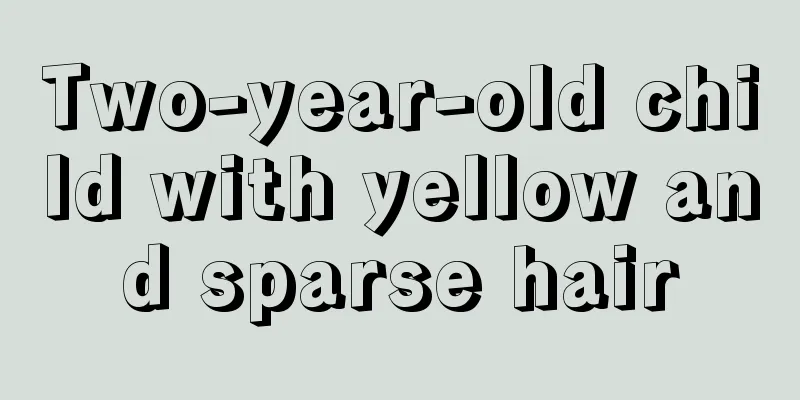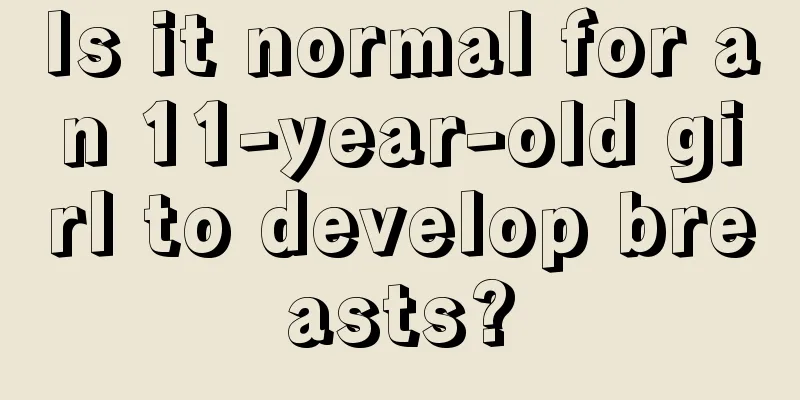Two-year-old child with yellow and sparse hair

|
For normal people, their hair should be black and thick, and hair can also reflect a person's nutritional health. Two-year-old children are in a critical period of growth and development. If parents find that their babies are malnourished, they must supplement their nutrition in time. Some two-year-old children have very yellow and sparse hair. Is it caused by malnutrition? 1. Yellow hair caused by genetic factors Most babies' yellow hair is related to genetic factors. Most of a person's characteristics are determined by the DNA that he or she is born with, such as height, figure, appearance, etc. Even hair is no exception. Some people with fair skin are more likely to have yellow hair. The reason is due to the production and utilization of melanin. This is normal and there is no need to worry. It should be mentioned that in addition to hair color, hair volume and hair growth rate are also related to genetic factors, and have nothing to do with whether you shave your head or not. Shaving your child's head will not make his hair grow better. The amount of hair you have at birth has nothing to do with how much hair you will have later in life. The growth of a baby's hair is just like the growth of his body, some grow early, some grow late, some grow fast, some grow slow. For most children, their hair will gradually change from sparse to dense, and from yellow to black as their bodies develop. A large amount of evidence shows that when a baby with thin hair is 1 to 2 years old, his hair will be no different from that of other children. 2. Malnutrition-related yellowing of hair Yellowing of hair caused by iron and zinc deficiency is more common in young children, but it is rare for babies who are getting enough milk. If genetic factors are ruled out, giving your baby a multivitamin supplement would be helpful. Eating too much sugar, fat and acid in the diet will cause the hair to turn yellow, and lack of certain trace elements (iron, copper, zinc, etc.). As you grow older and eat more food, your hair will naturally get better. Of course, we must first exclude those babies who are quite deficient in trace elements, so, they cannot be picky eaters! However, it would be too arbitrary to judge whether to give your baby additional nutrients based on the condition of his hair. The nutrients needed for hair growth account for a very small proportion of the total body nutrition. Therefore, if a child's hair turns yellow, there is actually no need to supplement with additional nutritional supplements, but adjustments can be made to the diet. Eat more foods rich in copper, such as animal liver, chicken liver, pork liver, duck liver, etc. Shellfish are also rich in copper, and oysters and clams can be eaten frequently. Streptavidin and cysteine are abundant in protein, so it is necessary to ensure that your baby consumes milk and eggs to supplement high-quality protein. Babies should be supplemented with calcium 15 days after birth and continue to do so until they are 2 years old. At the same time, they should take cod liver oil to promote calcium absorption. 3. Improper care can also cause children's hair to turn yellow Long-term use of adult shampoo or use of poor quality shampoo can cause children's hair to turn yellow. Babies aged 1 to 3 years old can use children's shampoo, and adult shampoos with many functions should not be used. Yellow or thinning hair should not be a reason to wash your hair less often. Some parents think that reducing the number of times their children wash their hair can make their hair thicker and healthier. In fact, the hair that falls out when you wash your hair is old hair, and it will fall out even if you don't wash your hair. On the contrary, if you don't wash your hair for a long time, the stimulation of oil and sweat will cause secondary infection, which will affect the growth of new hair. Some parents believe in folk remedies and rub ginger on their children's scalps or shave their heads, thinking that this will make their hair grow better. In fact, this practice is unhelpful and has no scientific basis. The method of shaving the baby's head more often to achieve more hair growth is even more dangerous, because when the razor shaves the baby's hair, many pores will be damaged in an invisible way to our naked eyes. In addition, if the razor is not clean or the skin on the head is not clean, bacteria will take the opportunity to enter the body, causing local small abscesses or skin suppurative infections. 4. Disease-related yellowing of hair There are also cases where children's yellow hair is related to certain diseases. Diseases such as rickets, copper and zinc deficiency, or genetic metabolic diseases can cause children's hair to become thin and yellow. There is also a genetic disease caused by inbreeding - phenylacetonide. The hair of the affected child becomes yellower as it grows longer, and his complexion becomes delicate and pale, his urine smells like rat urine, and his intellectual development is not fully developed. If the child's hair has not improved significantly around 1 year old, the child can go to the hospital for trace element and other related tests. And pay attention to adjusting the diet structure and strengthening physical exercise. |
<<: Two-year-old baby's legs are not straight
>>: How to stop cough for two-year-old baby
Recommend
What causes precocious puberty?
Precocious puberty has become a very common probl...
What to do if a 2-year-old child has a high fever and convulsions
Colds and fevers are common diseases among childr...
What should I do if my baby feels nauseous and spits up?
Spitting up is a common phenomenon in babies and ...
Baby sweating all over when sleeping
It is a common phenomenon for babies to sweat all...
How to treat myocarditis in children
Myocarditis is most likely to occur in adults, bu...
Why is the baby's lower eyelid red?
If the baby's lower eyelids are red, parents ...
Nine-month-old baby's schedule
For nine-month-old babies, they can already do a ...
Is it normal for babies to have mushy stools?
In fact, once we are unwell in our lives, we can ...
Nursing knowledge of pediatric fractures
Children are naturally curious and like to move a...
What to do if a child has a rash? That’s the scientific method!
Rash is a common skin disease. There are many typ...
Can I turn on the air conditioner when my child has a fever?
With the improvement of living standards, air con...
What are the symptoms and manifestations of encephalitis in children?
As we all know, encephalitis is a very serious di...
Six wrong ways to eat breakfast for children
The harm of skipping breakfast to children's ...
What to do if your child has small teeth
When a child starts to grow small teeth on his te...
What are the causes of big rashes in children?
There are many types of skin diseases. Children&#...









